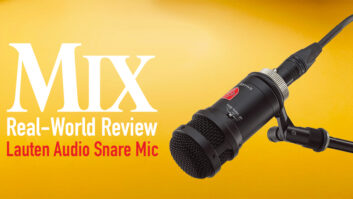This month, I still haven’t jumped off the local bus. I’m hangin’ on there, exploring the ramifications of…I know, you’re at AES in L.A., and you’d rather hear about great eating spots than dweeby computer jive. Okay, for lip smackin’ fish tacos, go to Senor Fish. For rich and hearty convergence technology, go with FireWire.
FireWire begins to meld the concept of device-attach protocol and serial bus into a true plug ‘n’ play package. The 1394 Trade Association, a collection of 170 computer, peripheral, pro and CE A/V vendors with a FireWire axe to grind, has ten groups working on topics from industrial control and automotive applications to compliance and inter- operability – my favorite. And yes, little Danny, there’s one for audio and video, too.
FireWire isn’t a network, per se, but it does play one on your digital set-top box. Its low-cost, flexible powering, dual asynchronous/ isochronous modes, backward and forward compatibility – as well as the ability to autonegotiate a comfy seat on the local bus along with 62 other peers – make it the perfect choice for networking of everything electronic. This means that, over time, we’ll see FireWire in ever increasing numbers of CE, prosumer and reinforcement audio gear as well.
Since the introduction of sliced bread, SCSI has dominated the performance-peripheral scene. For consumer applications however, SCSI is too costly. Enter FireWire, which started life at Apple with the moniker “ChefCat” before it became an international standard. The IEEE created the first vendor-neutral standard version of FireWire in 1995. The original called for a four-wire unpowered or six-wire powered bus that went a long way toward trading off convenience and low cost for speed.
Since this is the Year of the Bus Upgrades, I’m here to extol the virtues of 1394b, an interesting long-distance, high-speed extension to the 1995 original. 1394b, or “Beta” for short, adds so many new features it boggles my addled mind. Although the copper physical layer with two twisted pairs hasn’t changed, the transmission is now dual simplex, with each pair continuously transmitting in each direction. Improved channel coding, employing the same 8B10B method used in Fibre Channel and Gigabit Ethernet, means that copper links radiate very little noise, a pleasant surprise in this RFI-enriched world. This also simplifies the analog design, making end-user products less expensive. Cleverly designed, dual-shielded, compact connectors allow hot plugging and protect against ESD (electrostatic discharge) damage.
Intended for more than 1,000 mating cycles, the connector comes in two flavors. There’s the familiar four-pin miniature version (Figure 2) that appears on consumer DV camcorders. This 1394a-2000 S200 connection, usually called 1394AV or iLink, doesn’t carry the extra power pins and is intended for battery-powered products operating between 100 and 400 Mbits per second. Then there’s the six-pin version, a new compact, keyed, 110-ohm latching design that carries up to 30 VDC along with the data. The max rate for this puppy is 3,200 Mb/s.
Another low-speed alternative is the tried-and-true team of UTP decorated with RJ-45s. This yields 100 Mb/s over a 75-meter distance and shares the same connectors, cables and tooling that are used for old-school Ethernet.
Getting back to its roots, 1394b’s support for glass and POF (Plastic Optical Fiber) enables really long runs. Apple had originally envisioned ChefCat as being carried on glass fiber, but that was deemed too expensive at the time. Though glass can handle 3,200-megabit data rates over long distances, duplex POF is a great way of getting 400 Mb/s around your crib, car or project studio. Besides, it’s a breeze to terminate and connectorize. For POF, there are two connector types. One is a PN FO 7 series (Fig. 3), which looks like two AES Type II optical connectors superglued together. This guy runs at a max speed of 250 Mb/s. The other is a latching connector, the SMI or Small Multimedia Interface (Fig. 3), which employs either laser or LED transceivers and runs at 400 Mb/s. SMIs are very small and should appear for the first time in CE products around Christmas.
Then there’s glass…we’re talkin’ a possible 4 Gb/s here – serious speed. There are even optical to electrical long-haul repeaters available, so your Webcast of this weekend’s impromptu jam can head out onto the patio at a moment’s notice.
FireWire is a point-to-point connection model, configured like leaves on a branch. In 1994-1995, it was relatively easy to accidentally create a loop when your rig got a bit complicated. This brought the whole bus to its knees. In 1394b, it’s no longer a problem. A new “loop healing” capability automatically breaks the loop for you.
I mentioned both backward and forward compatibility, a neat trick. Each device runs at its own maximum speed while on the same bus. Try that with SCSI. Running “legacy” 12.5Mb/s products and 1,600Mb/s beta devices on the same bus is also accomplished without the user worrying about physical bus ordering. Try that with USB 2.
By now, you should know I’m a wild-eyed, FireWire fanatic. I foresee a couple of POF runs replacing all that snarl of wiring in your future car, which means that next year, DVD-A/V car player (see sidebar) will have 1394 on the back. But wait, that means encryption, since no self-respecting content holder would allow 24/96 data to be passed around without content protection. But, 5C and their DTCP system is a subject that we’ll get to in good time.
However, with all this happy 1394 talk, there’s still trouble in River City. Next month, I’ll get into the dark side of my favorite bus. No, not Microsoft’s initiative to bring 1394 to the Win world, but the problems of interoperability that are cropping up in the FireWire arena. I’ll also show off what some audio vendors are doing with the technology. `Til then, stay clean and shoot a note to [email protected] with your innermost hopes and desires.
Though not covering the SACD base and lacking that dreamt-of 1394 port, Matsushita’s Panasonic division announced a new product as this issue went to press. Its in-dash model CQ-DVR909U ($1,999.99) combines DVD-A and V capabilities along with a digital radio receiver. I could not believe this thing, with its swing out, motorized “center channel speaker” replete with robo-Highlander ka-ching sound effects, mirror finish cybercase with color display and wireless remote so the kids can watch videos in the back seat. I can’t help it, it’s kewell.




